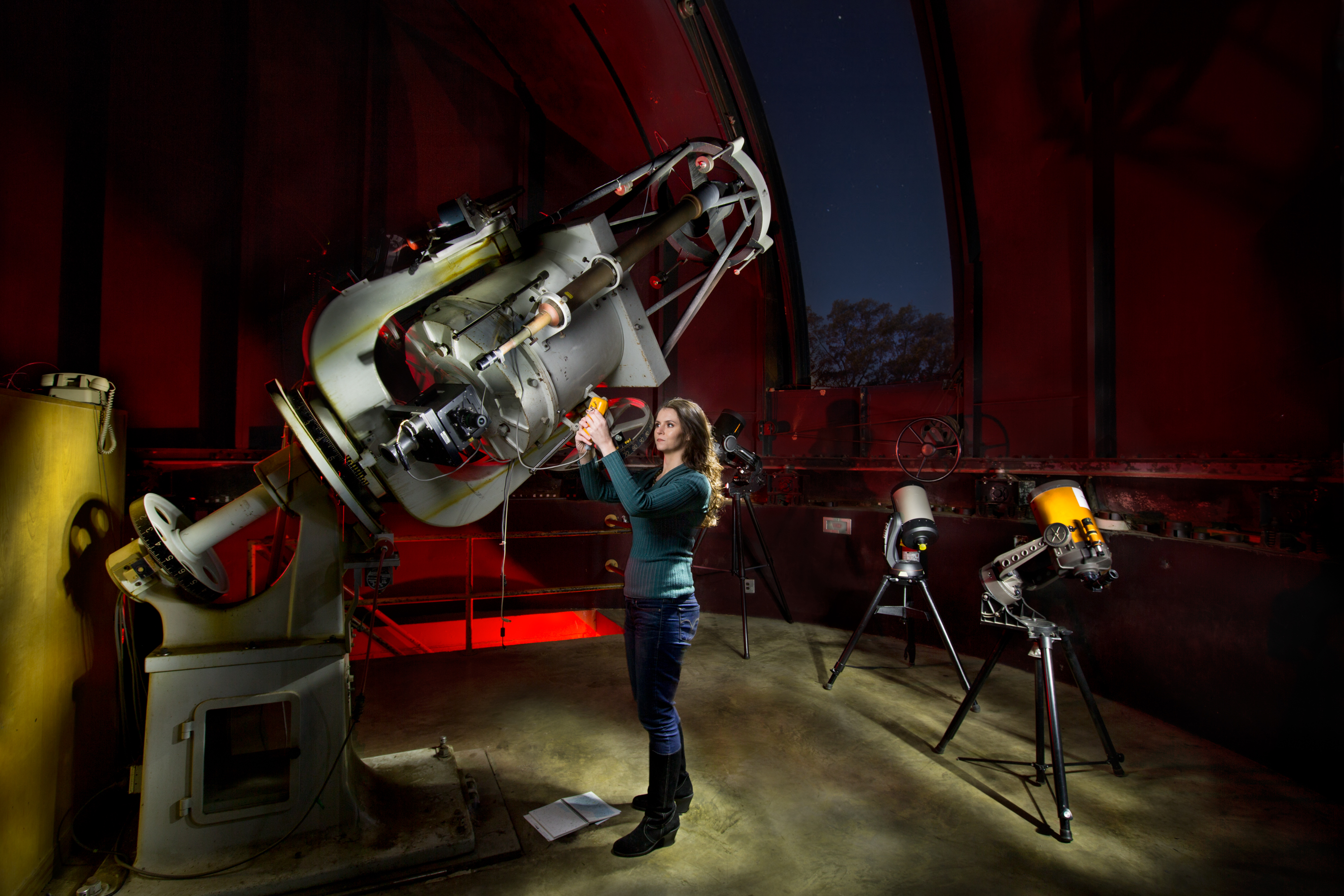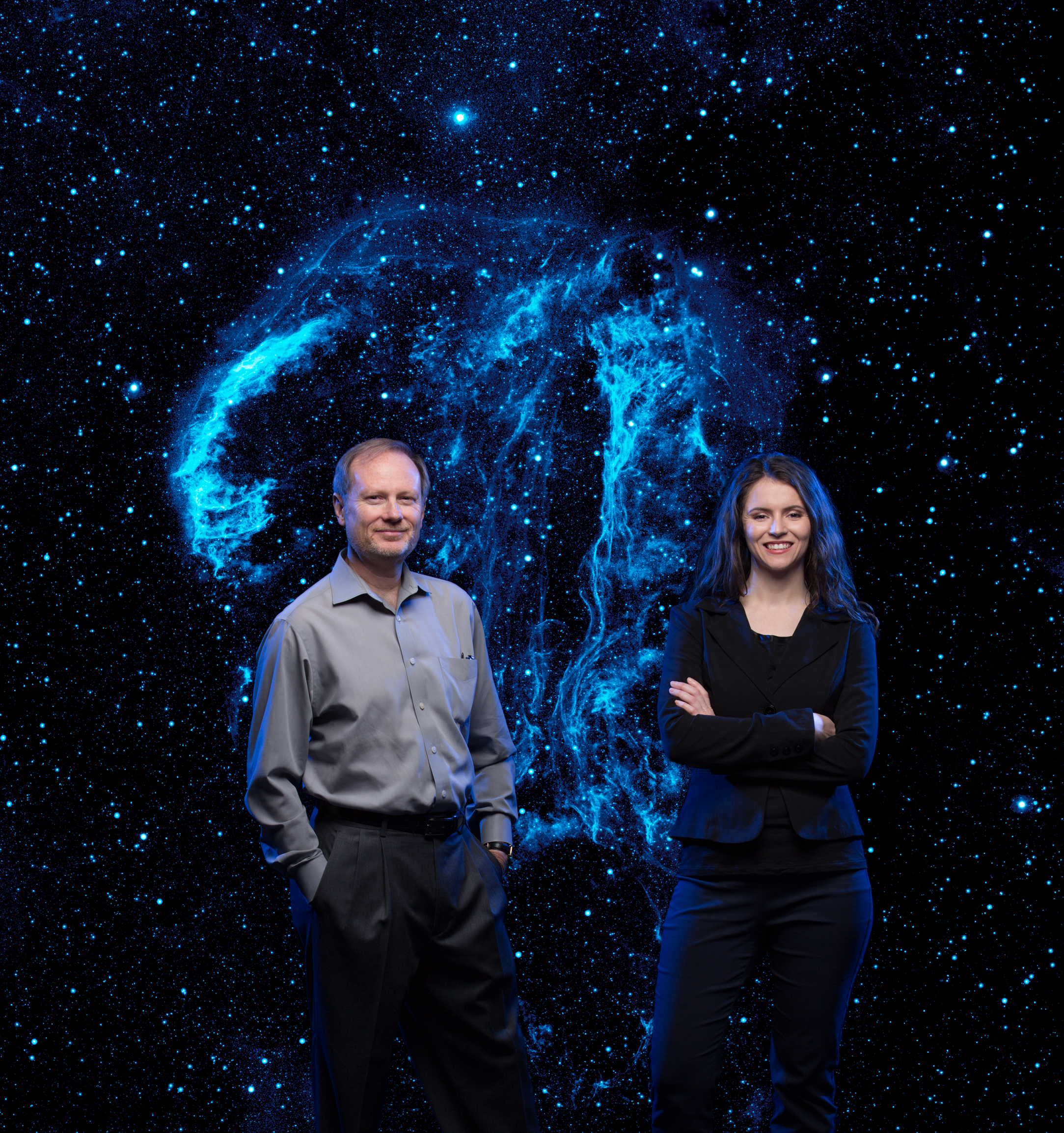To Wish Upon a Distant Star: The Far-Sighted Vision of Renata Cumbee
By: Cynthia Adams | Photos By: Nancy Evelyn
Women in astronomy and physics are no longer rare, nor their work so obscured. American astronomer Vera (Cooper) Rubin was born in 1928. In the 1970s she observed that stars which were at the edges of galaxies moved faster than previously known. Her observations anticipated the invisible matter known as dark matter.
At age 87, Rubin continues her work at the Department of Terrestrial Magnetism at the Carnegie Institution of Washington. She is widely recognized for significant scientific contributions.
Astrophysicists at UGA count women among their numbers, like doctoral student Renata Cumbee. They may be walking a similar path toward scholarship and discoveries in deep space—while keeping their eye upon a distant star.
In Cumbee’s hometown of Cordesville, SC, the night sky was boundless. It turns out that her dreams were as well. Now she is bound for NASA to begin a postdoctoral Fellowship Program at Goddard Space Flight Center this fall.
As an historic bit of serendipity, the news of her fellowship broke upon the same day, February 11, as a team of astrophysicists confirmed the recorded sound of gravitational waves. The sound, called a “fleeting chirp”, was produced by two black holes a billion light years away. This enormous achievement validated Einstein’s final prediction in his general theory of relativity.
Renata Cumbee is a scientist, but one who can talk about astrophysics in poetic ways. “I wanted to study something intangible that you cannot touch,” she explains, drinking a cup of tea. Now approaching her final year of a doctoral program, Cumbee talks about her own particular pathway to the stars, so to speak. Cumbee says it is “so beautiful, that you can study something without holding it.”
She is hesitant at first; most of the precise research nomenclature is unfamiliar at best to a layperson. In order to make galactic calculations, the science of mathematics, physics, and astronomy are in play; none easily translated. To even become an astrophysicist, Cumbee joined a very select endeavor—a subset of science that is both demanding and exclusive. By some estimates, only 1,200-1,500 doctorates in physics are awarded each year. To become an astrophysicist, one first has to master mathematics and make complex calculations.
She was not born to mathematicians, nor born a child of privilege; Cumbee was a product of public schools and has had to work to earn her place in astrophysics. She had never met an actual scientist, but only watched them on television, when she began imagining what it would be like to be a scientist. By adolescence, she had set her sights on pursuing something very different from her young friends.
“By ninth grade I decided I was going to be a scientist. Maybe an astronomer, or a molecular biologist, or Nano scientist.” This was a powerful dream for a kid in a small southern community. Cumbee’s first inspiration points were in history, archaeology and science, but all were vicarious ones.
Today, Cumbee sits in a busy café filling with students close to the UGA campus. Nearby, a small knot of education students are discussing literacy and the challenges of engaging young minds in literature. Yet Cumbee is among a coterie of women working at the intersection of physics and astronomy.
“I am an astrophysicist,” she says. “I study physics problems and apply them to astronomy—and I identify more with physicists because, I think, I enjoy the physics.”
Later this year, she begins a fellowship at NASA, possibly related to her current studies in supernova remnants. (Her UGA research is on charge exchange emission in the Cygnus Loop supernova remnant.)
At UGA, a respected research institution, she is not alone and has found a collegial environment. Cumbee is one of several women graduate students working in physics and astronomy at UGA. Her advisor is Phillip Stancil, whom she describes in glowing terms. She discusses research travels to China and Japan presenting her work—her university mentors are supportive and accessible.
Virtual Mentors: Cosmos and Nova
Before she became a first generation college student, many of Cumbee’s role models were the ones who demystified science on television programs, including Carl Sagan, host of Cosmos, or Brian Greene’s appearances on Nova. These, she says, were the first people to cause her to fall in love with science.
As a young girl, Cumbee was initially influenced by watching educational programs about science or archaeology and then discussing them at school. She discusses her life coming of age in Cordesville, SC, a community outside Charleston. Cordesville is a small community near a national park. “The town is 5,000-7,000 people,” she says about her birth place. “But it recently got a sign that says ‘City’,” she smiles.
She remembers watching guest scientists on the Discovery Channel discuss scientific matters. Cumbee also found an advocate in some early teachers where she attended public school in Moncks Corner. By the fourth grade, Cumbee was taking honors courses. “People started encouraging me to do well in school.”
Then, Cumbee had a female science teacher in her fifth grade. The teacher noticed that she enjoyed science. “I know she told the next science teacher (in sixth grade) that I was a good student and interested.” Other teachers also encouraged her in subtle ways. “Mr. Laddie Jones is still teaching in Moncks Corner. I cannot pinpoint what he did, but he showed an interest in my doing what I wanted to do.” But it was her ninth grade teacher who nudged her forward. His name, she recalls, was “Mr. Sweeney.”

Renata Cumbee. Photo taken in observatory. A doctoral candidate in Physics, Renata Cumbee works on improving our understanding of X-ray radiation produced within our galaxy. “Her research specifically studies supernova remnants and the changes they make as they travel through the material that fills the space between the stars (also known as interstellar medium).”
Cumbee’s primary research here at UGA includes calculating the spectra of X-rays produced after such a charge exchange collision and directly comparing them to experiments done by groups at other research institutes.
Sweeney identified Cumbee and another female as top students, both earning good marks. He noticed the boys often dominated in class, overshadowing the girls when they had the correct answers. The girls had hesitated, he noticed. The teacher asked for Cumbee and her friend to cooperate with a social experiment in his classroom, one that wound up
being revealing.
“Mr. Sweeney gave me and the other girl the correct answer to the (in class) experiment. But the boys elbowed us out of the way.” The lesson was that his young charges should not back down, especially when they knew that they were right—Cumbee was mature enough to understand the value of what the teacher had shown them.
Further strengthening her interest was meeting celebrity scientist and commentator Neil deGrasse Tyson. “He came to a two-week camp for junior scholars in South Carolina, and gave a talk about being an astronomer,” recalls Cumbee. “I didn’t think too much about physics. I kind of wanted to do this theoretical part—astrophysics.”
Tyson became a champion for demystifying science and also for equal opportunities within STEM disciplines. Over a decade ago, while speaking at the National Academy of Sciences, Tyson himself was asked “whether genetic differences might keep women from working as scientists.” Tyson replied that becoming an astrophysicist was “handsdown the path of most resistance through the forces … of society.” He continued: “My life experience tells me, when you don’t find blacks in the sciences, when you don’t find women in the sciences, I know these forces are real and I had to survive them in order to get where I am today.”
Fortunately for Cumbee, by the time she was accepted into graduate studies at UGA, she joined a progressive department and was not elbowed out of the way. Her Georgia colleagues treat her well, she stresses.
But it is well-known that elsewhere, women have not found easy acceptance in the field of physics. Women did not gain admission to Ivy League astronomy programs (like Princeton’s) until as late as 1975. Many decades after Vera Rubin attempted to get a Harvard graduate school catalog, and failed, she was given an honorary doctorate by the same institution.
“There are a significant number of women in astronomy,” Cumbee says, “but not so many professors as compared to physics.” However, her life today at a large research institution is a very different experience than for a young student in the South, where only science teachers could support her dreams. But perhaps lessons in early life have equipped Cumbee to deal with a future in a mentally demanding field—astrophysics.
“There are a significant number of women in astronomy, but not so many professors as compared to physics,” says Cumbee. Her life today at a large research institution is a very different experience than for a young student in the South, where only science teachers could support her dreams.”
NASA and the Early Workings of the Universe
Today, the inspirational Tyson is both a celebrity and astrophysicist associated with NASA. The four-letter acronym most school children and aspiring scientists know by the time of literacy, describes work within the firmament in vivid terms and evocative language. Astrophysics is the framework NASA employs for their most important endeavors. “The science goals of astrophysics are breathtaking: we seek to understand the universe and our place in it,” states NASA online. “We are starting to investigate the very moment of creation of the universe and are close to learning the full history of stars and galaxies. We are discovering how planetary systems form and how environments hospitable for life develop. And we will search for the signature of life on other worlds, perhaps to learn that we are not alone.”
NASA summarizes: Astrophysics works toward discovering the workings of the universe, its beginnings and evolution, and life on planets elsewhere. This is the promise of astrophysics: it is the promise of discovery.
Cumbee understands the promise of discovery in her research with atomic collisions.
“We do the calculations for the collision; this involves some quantum mechanics and it is just fascinating to me what we are looking at. We take the results and compare it to what we observe. So, we take these calculations and throw them into the observed spectrum. If it matches, we can say this collision is happening. Right now it hasn’t been proven to have happened outside our solar system. I think that the fact that we can get more details out of the physics makes it more interesting.”
And there is both inspiration and bewilderment to be found in the details. The arguments of physicists, it is said, are the sounds of progress. Cumbee is inspired and influenced by books such as Spooky Action at a Distance by George Musser. She discusses the title’s inspiration, which references entangled photons.
Late last year, John Gribbin reviewed Musser’s book, explaining how Einstein used the term “spooky action at a distance” to explain causality and entangled photons, which seem entangled even when far apart. “Poke one particle, in the right quantum-mechanical way, and the other particle jumps, instantly, even if it is on the other side of the universe. Einstein did not mean the term as a compliment, and did not believe that the effect could be real. Alas for Einstein, experiments based on the theoretical work of the physicist John Bell some 30 years ago proved that this entanglement is real.”
In the process of rebutting spooky action, physicists proved something which is called “local reality.” Yet, that, too, isn’t a term easily explained to nonscientists. But it is the terminology that is the working language of Cumbee and her colleagues.
“Local reality says that there is a real universe out there, even when we are not observing it,” Gribbin says. “The ‘local’ bit of the name says that these real objects can only affect one another by means of influences that travel at less than or equal to the speed of light. In entanglement experiments, however, ‘locality’ seems to be violated. Alternatively, there may not be a real world out there that exists independently of our measurements—‘reality’ may be what is being violated.”
And so it may take a brand new Neil deGrasse Tyson—perhaps even a young astrophysicist from Cordesville, SC—to interpret spooky action, and local reality, for a new generation of Discovery watchers.
As the mysteries of gravitational waves and the earliest moments of the universe further unfold this year, we will be watching, too.
“Astrophysics works toward discovering the workings of the universe, its beginnings and evolution, and life on planets elsewhere. This is the promise of astrophysics: it is the promise of discovery.”
— NASA

Physics Prof. Phillip Stancil & PhD student Renata Cumbee. Photographed in studio for illustration. NOTE: Star background is an ultraviolet image of the Cygnus Loop taken by NASA’s Galaxy Evolution Explorer (NASA/JPL-Caltech








